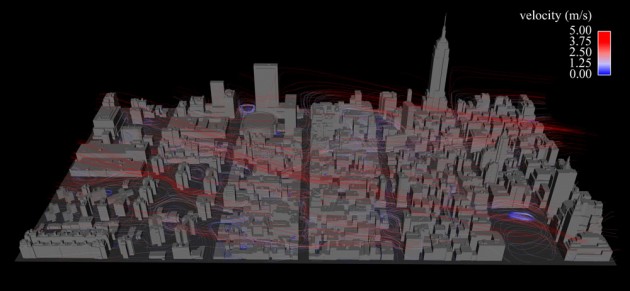Alan Huber spent an entire career with the US Environmental Protection Agency studying how pollutants disperse on the wind through urban environments.
The question is tricky and important to understanding urban air quality and how particulates disperse, whether they are the pollens, dust, and carbon monoxide fumes that are constantly carried through the urban environment, accidental emissions of pollutants, or emissions caused by anything from fires to building demolitions. Airflow is complicated by urban geography; narrow streets lined with skyscrapers and smaller buildings prevent air currents from moving uniformly across the cityscape and cause updrafts and downdrafts.
Since retiring from the EPA in 2007, Huber, now an adjunct faculty member with the Institute for the Environment at the University of North Carolina at Chapel Hill, has continued his research with help from RENCI visualization specialists and the computing power of UNC’s Topsail, a 520-node (4,160 processor) supercomputing cluster with a peak performance of nearly 29 teraflop/s.
“I’m interested in the micro-environments in urban areas; how particles disperse at a spatial scale of about one meter,” Huber said. “Direct simulation of this kind of process has only been possible for a few years.”
Simulations of such detailed movement of particles through real environments requires using computational fluid dynamics (CFD), numerical methods and algorithms that solve and analyze problems involving flows of fluids and gases over complex surfaces. The work is extremely computationally intensive: Huber used between 128 and 512 processors on Topsail for a series of compute jobs over several months in 2007. After simulating his data, he turned to RENCI at UNC Chapel Hill, then a new resource on the UNC campus, to translate the data into a more intuitive format for study. “I had thousands of gigabytes of data, but I wanted to be able to interact with it and look at in three dimensions over time,” explained Huber.
Enter David Borland, a senior visualization researcher at RENCI at UNC Chapel Hill. Borland began working with Huber to turn his massive dataset into three- dimensional visualizations showing airflow over time among the buildings of lower Manhattan and how particles travel along these wind currents. Huber’s full 54 million-cell dataset was too large to visualize interactively, so the team took a smaller geographical area, including such landmarks as Madison Square Garden and the Empire State Building, and began building a visualization that shows airflow over two-to-five hours in five-minute time steps.
Huber, whose past work includes simulating particle dispersion caused by the collapse of the north tower of the World Trade Center, said the current lower Manhattan visualization interests homeland security experts who want to be prepared for possible terrorist attacks involving airborne particles. Its relevance also extends to environmental engineers, urban planners, political leaders and others who need to understand how new buildings, traffic patterns and other variables affect air quality and, by extension, public health.
Recently, Borland and Huber ported the airflow simulation to the high resolution, stereoscopic tele-immersion system at RENCI, where they can view it in three dimensions and at street level. Next the team plans to visualize the entire dataset and run visualizations in RENCI’s dome environment. Using the dome, said Borland, will create an immersive experience, where the researchers can look in any direction, even over their shoulders, and see the particle flow.
“If you’ve spent some time in a city, you know the wind will be in your face and then a half of a block down it’ll be at your back due to the influence of buildings,” said Huber. “We want to create that real experience as much as possible.”
RENCI…Catalyst for Innovation
The Renaissance Computing Institute brings together teams of talented researchers, engineers, technologists and leaders in government, business, the arts and humanities to attack major research questions and community issues in ways that accelerate discovery and drive innovation. RENCI has nationally significant expertise and capabilities in high performance computing, visualization, collaborative tools, networking, device prototyping, and data systems as well as engagement sites across the state. Founded in 2004 as a major collaborative venture of Duke University, North Carolina State University, the University of North Carolina at Chapel Hill and the state of North Carolina, RENCI is a statewide virtual organization. For more, see www.renci.org.



